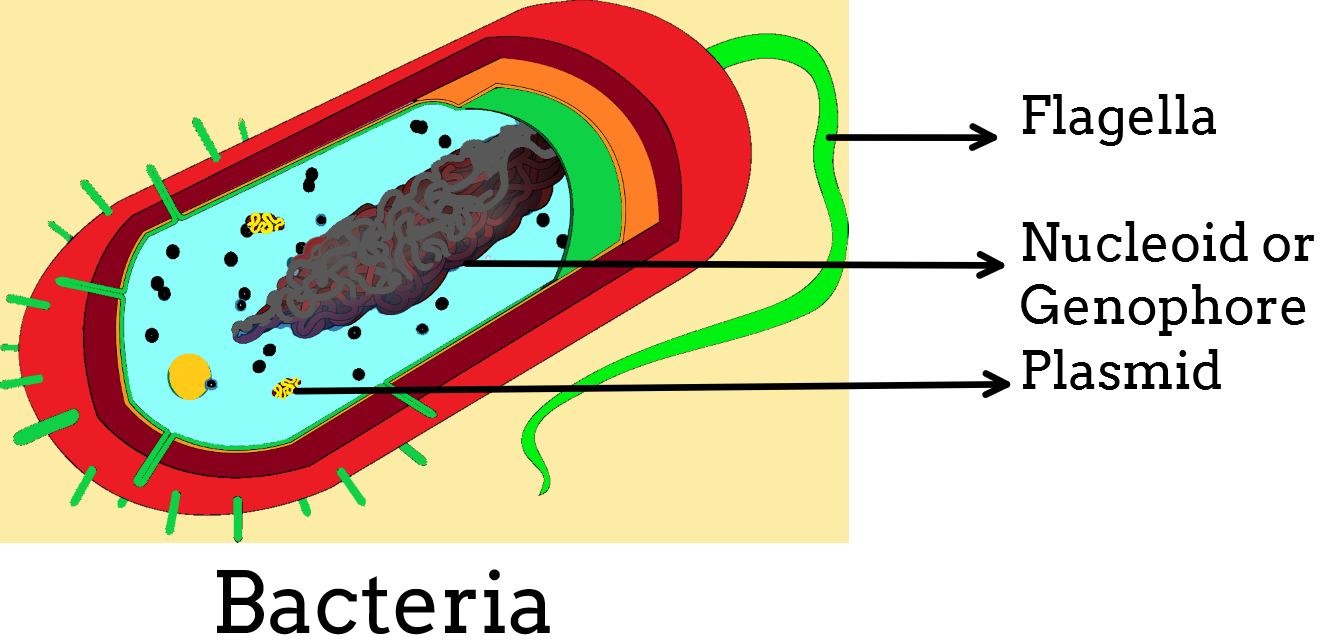Answer
395.7k+ views
Hint: Examples of this cell are bacteria and Archaea. These contain appendages like flagella, pili, and fiber used as the locomotory organ or to capture food. They have a cell envelope containing glycocalyx in either capsule or slime layer.
Complete answer:
Prokaryotic cells have a primitive nucleus that means the nucleus is not surrounded by the nuclear membrane. Prokaryotes contain a circular loop of DNA without non- coding regions. These are devoid of the nuclear envelope thusDNA of the cell aggregates in a dense area of the cell known as the nucleoid.
Additional Information:
-The prokaryotic cells have cell envelopes and cell membranes made up of peptidoglycan.
-Based on the cell wall composition Hans Christian Gram divides the bacteria into two types- gram-positive and gram-negative.
-Prokaryotic cells contra extracellular material known as plasmids.
-Prokaryotic cells have 70s ribosomes which consist of small subunit 30s and large subunit 50s.

So, the correct answer is, ‘ prokaryotic cells.’
Note: -Gram-positive cells have many layers of peptidoglycan and teichoic acids and when stained form crystal violet- teichoic acid complex.
-Gram-negative cells have a very little amount of peptidoglycans and teichoic acid.
-Gram non reactive cells are those cells that have peptidoglycan but very waxy thick lipids waterproof, thus dyes cannot enter either. Examples- Mycobacterium tuberculosis and leprosy.
Complete answer:
Prokaryotic cells have a primitive nucleus that means the nucleus is not surrounded by the nuclear membrane. Prokaryotes contain a circular loop of DNA without non- coding regions. These are devoid of the nuclear envelope thusDNA of the cell aggregates in a dense area of the cell known as the nucleoid.
Additional Information:
-The prokaryotic cells have cell envelopes and cell membranes made up of peptidoglycan.
-Based on the cell wall composition Hans Christian Gram divides the bacteria into two types- gram-positive and gram-negative.
-Prokaryotic cells contra extracellular material known as plasmids.
-Prokaryotic cells have 70s ribosomes which consist of small subunit 30s and large subunit 50s.

So, the correct answer is, ‘ prokaryotic cells.’
Note: -Gram-positive cells have many layers of peptidoglycan and teichoic acids and when stained form crystal violet- teichoic acid complex.
-Gram-negative cells have a very little amount of peptidoglycans and teichoic acid.
-Gram non reactive cells are those cells that have peptidoglycan but very waxy thick lipids waterproof, thus dyes cannot enter either. Examples- Mycobacterium tuberculosis and leprosy.
Recently Updated Pages
How do you arrange NH4 + BF3 H2O C2H2 in increasing class 11 chemistry CBSE

Is H mCT and q mCT the same thing If so which is more class 11 chemistry CBSE

What are the possible quantum number for the last outermost class 11 chemistry CBSE

Is C2 paramagnetic or diamagnetic class 11 chemistry CBSE

What happens when entropy reaches maximum class 11 chemistry JEE_Main

Calculate the volume occupied by 88 gram of CO2 at class 11 chemistry CBSE

Trending doubts
Difference Between Plant Cell and Animal Cell

Difference between Prokaryotic cell and Eukaryotic class 11 biology CBSE

Fill the blanks with the suitable prepositions 1 The class 9 english CBSE

Change the following sentences into negative and interrogative class 10 english CBSE

Summary of the poem Where the Mind is Without Fear class 8 english CBSE

Give 10 examples for herbs , shrubs , climbers , creepers

Write an application to the principal requesting five class 10 english CBSE

What organs are located on the left side of your body class 11 biology CBSE

What is the z value for a 90 95 and 99 percent confidence class 11 maths CBSE



